
Ommastrephidae is a family of squid containing three subfamilies, 11 genera, and over 20 species. They are widely distributed globally and are extensively fished for food. One species, Todarodes pacificus, comprised around half of the world's cephalopod catch annually.

Pyroteuthidae is a family of squids. The family comprises two genera. Species are diurnally mesopelagic, migrating into surface waters during the night. The family is characterised by the tentacles, which have a permanent constriction and bend near the base; and photophores occurring on the tentacles, eyeballs, and viscera. Members reach mantle lengths of 23–50 mm. Paralarvae of the family are common around the Hawaiian Islands, with up to 17% of collected specimens in the area belonging to Pyroteuthidae.
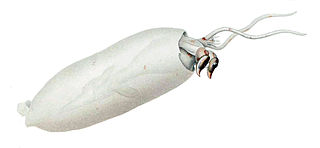
Taoniinae is a subfamily containing ten genera of glass squids.
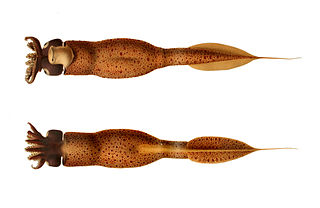
Taonius is a small genus of glass squid. Although it comprises only three recognised species, it has been suggested there may be as many as five species. Taonius borealis is found in the North Pacific Ocean and Taonius pavo is found in the Atlantic and possibly SW Indian Ocean.
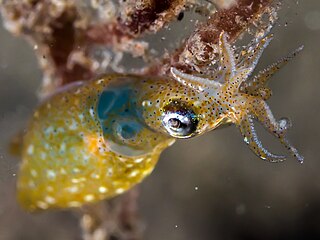
Idiosepiidae, also known as the pygmy squids, is a family of squids in the superorder Decapodiformes. They are the smallest known squids.

The Japanese flying squid, Japanese common squid or Pacific flying squid, scientific name Todarodes pacificus, is a squid of the family Ommastrephidae. This animal lives in the northern Pacific Ocean, in the area surrounding Japan, along the entire coast of China up to Russia, then spreading across the Bering Strait east towards the southern coast of Alaska and Canada. They tend to cluster around the central region of Vietnam.
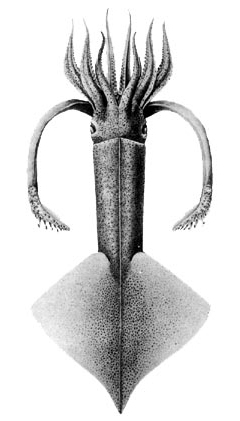
Onychoteuthis is a genus of squid in the family Onychoteuthidae. The type species is Onychoteuthis bergii. While the genus is found worldwide in tropical and subtropical oceans, they can also occur in the North Pacific Ocean. There were previously considered to be four species in the genus but there are now considered to be roughly 10. These squid are frequently observed in the surface waters at night and they are often caught using dipnet at nightlight stations. The young squid are usually the only specimens captured using standard midwater trawls, the older squid are apparently able to avoid the trawls. They can, however be collected from the air as individuals are able to leap high out of the water, sometimes even landing on the deck of a ship.

Onykia is a genus of squids in the family Onychoteuthidae. Due to similarities between the genera, several recent authors consider the genus Moroteuthis a junior synonym of Onykia. The type species is Onykia carriboea, the tropical clubhook squid.
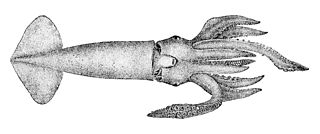
Nototodarus is a genus of squid. Example species in this genus include Nototodarus sloanii, a species sought for human food; in the process of harvesting N. sloanii Australian sea lions are frequently killed, since that marine mammal preys upon this squid species. Furthermore, New Zealand arrow squid, N. sloanii, is an important food source for the endangered yellow-eyed penguin, Megadyptes antipodes.

Todaropsis eblanae, also known as the lesser flying squid, is a species of short finned squid in the monotypic genus Todaropsis of the family Ommastrephidae.

Todarodinae is a squid subfamily in the family Ommastrephidae.

Martialia hyadesii is a species of flying squid commonly known as the sevenstar flying squid.
Aggregata is a genus of parasitic alveolates belonging to the phylum Apicomplexa.
Loliolus is a genus of squid from the family Loliginidae from the Indo-Pacific region. The genus is divided into two subgenera Loliolus and Nipponololigo. They are small squids of less than 150mm in mantle length which have an expanded tentacular club. This club has 4 series of suckers. The sucker rings have plate-like teeth which are square in shape all around them. The males' hectocotylus has a ventral crest which is created by the fusion of the protective membrane with the ventral series of papillae and this crest completely obscures the conical shape of the papillae. The mantle is rounded posteriorly and lacks the posterior tail-like lobe while the fins are positioned on the rear of the mantle and extend to the posterior tip of the mantle. Their eggs are small and the males' spermatophore has a short cement body. They do not possess photophores. The two subgenera are distinguished by the hectocotylus which in Loliolus encompasses the entire arm and there are no unmodified suckers while in Nipponololigo the arm is only partly hectocotylsed and has normal suckers at its base.
Lolliguncula is a genus of squid from the family Loliginidae from the eastern Pacific and western Atlantic, known as brief squid. The genus is divided into two subgenera Lolliguncula and Loliolopsis. They are rather small squids with a maximum mantle length of 120mm, that inhabit shallow warm seas, although some species have been recorded in areas of low salinity. They are typified by having a short mantle, which is round at the posterior; and fins that are broader than long, but which have no posterior lobes. The males produce spermatophores with a long cement body and they lack a ventral crest on their hectocotylus. Their suckers have square teeth which ring the entire margin or are placed distally. The males do not have enlarged suckers on the left ventral arm. The tentacular club is expanded and contains suckers in four series. The two subgenera differ in the morphology of the hectocotylus.
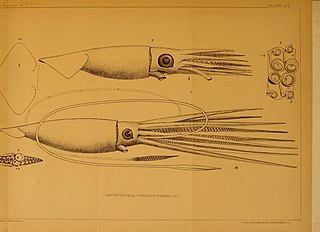
Sthenoteuthis is a genus of small squids, with two species, part of the subfamily Ommastrephinae within the family Ommastrephidae, the "flying squids". They are the dominant species of flying squid in the world's tropical and subtropical seas and they are commonly seen at the ocean's surface during the night. Their size ranges from mantle lengths of 100 mm to 600 mm.
The Angolan flying squid is a species of squid from the subfamily Todarodinae, part of the familyOmmastrephidae. Due to taxonomic confusion with the Antarctic flying squid the exact limits of its distribution are uncertain but it is thought to be restricted to waters off Southern Africa.
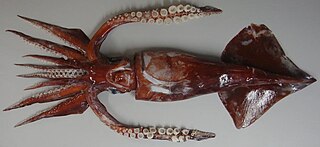
The Antarctic flying squid is a species of squid from the subfamily Todarodinae of the family Ommastrephidae, a family of pelagic squid from the order Oegopsida. It has a circumglobal distribution in the seas around the lower latitudes of the Southern Oceans.
The little flying squid is a species of squid, one of the arrow squids of the genus Todarodes, in the subfamily Todarodinae of the flying squid family Ommastrephidae. It is a small species from the waters around northern Australia and Indonesia.

The European flying squid is a species of squid from the continental slope and oceanic waters of the eastern Atlantic Ocean and the Mediterranean Sea. It is the type species of the genus Todarodes, the type genus of the subfamily Todarodinae of the pelagic squid family Ommastrephidae. It is a species which is targeted by some fisheries, although it is more often a bycatch.













